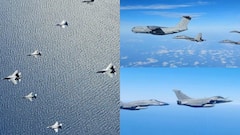OPINION: Why Defence Budget For 2023-24 Is Not Adequate For A Two-Front War
Besides the China-Pakistan threat on land borders, India's economic and strategic interests in maritime area are also being challenged. Countering everything simultaneously requires huge funding.

India’s defence budget for the coming fiscal (2023-2024) has seen an impressive 13 percent increase, which on the face of it looks very robust but lacks enough meat inside. Over the last few years, the Indian defence budget has seen a modest 5-9 percent yearly rise, but this year’s rise of 13 percent means little to armed forces as a substantial chunk of the budgetary provisions relates to pension payments to retired 35 lakh soldiers and defence civilians, which has burgeoned to over Rs 1,38,000 crore. This is a steep rise in the pension liability due to the government's decision to grant “one rank one pension” to all the retired soldiers.
Out of the total defence budget of Rs 5,94,000 crore, the allocation for capital outlay pertaining to modernisation and infrastructure development has been pegged at Rs 1,62,000 crore, which is only a marginal rise of 6.7% over the previous year. Since most of the expenditure on weapons and spare parts imports is done in foreign currency, this modest rise in budgetary provisions in Indian currency is neutralised by the recent sharp devaluation of Indian rupee vis-a-vis US dollar. In spite of efforts to be 'atmanirbhar', i.e. self-reliant, in defence equipment, India continues to be the largest importer of weapon systems, which requires hard currency for payments.
However, the defence ministry claims that in order to make the armed forces battle ready and to meet any eventuality, non-salary outlay has been enhanced significantly from Rs 62,431 crore in budget estimates 2022-23 to Rs 90,00 crore in 2023-24, registering a jump of 44%. According to ministry officials, this enhanced increase will fill critical gaps in the combat capabilities and equip the forces in terms of ammunition, sustenance of weapons and assets, military reserves etc.
The mounting security challenges before India requires a proportionate defence preparedness, but over the years India’s defence modernisation has been moving at a very slow pace. Lack of budgetary provisions has forced the armed forces to give priority to filling the critical gaps first. Most of the weapon systems and platforms are ageing as some of them were acquired way back in the 1970s. As testified before the Parliamentary Standing Committee on Defence in 2018, the then vice-chief of Indian Army Lt. Gen. Sarath Chand had said that 68% of our equipment is the vintage category, with just 24% in the current and 8% in the state-of-the-art category. According to senior Army officials, the situation has not changed much since. There have been only a few new inductions, such as attack helicopters, Howitzer guns etc, but they are in limited numbers, and the bulk of combat soldiers still remain underequipped. The long standing plan to convert Indian soldiers as modern as American soldiers for which the Indian Army has been working on a two-decades-old plan, called 'Infantry soldier as a system', is still far away from full realisation.
The Requrements Of Armed Forces
The Indian Air Force (IAF) fighter squadron strength is also fast depleting, notwithstanding the recent induction of 36 French Rafales, which indeed is the most cutting-edge fighter in the fleet. But mere two squadrons would not meet the challenge of simultaneously tackling the joint threat of China and Pakistan, as the two have a common agenda to dismember and weaken India. The IAF needs 45 fighter squadrons, as recommended by the Parliamentary Standing Committee on Defence decades ago, but the strength has come down to a precariously low level of 29 squadrons.
The plan to acquire 126 fighter planes has still not materialised even after two decades of efforts. Instead, the IAF has been provided 36 Rafales. The IAF needs the multi-role fighter urgently as Russian Mig fighters of various variants are retiring from service. Even the French Mirage-2000 and the British Jaguars are over three and a half decades old. These fighters need immediate replacement. However, as a top priority, the government must complete the unfinished agenda of acquiring 120 medium multi-role fighters.
As far as the Indian Navy is concerned, half of its submarine fleet of 16 is getting old and needs replacement. The four German HDW and ten Russian Kilo class submarines were inducted in the nineties. Though six Scorpene class submarines have joined the Indian Navy, the strength is not optimum. Six more diesel electric submarines are also planned to be inducted, but the move that began a decade and half ago does not seem to have seen much progress.
Less Than 2% Of GDP Spent On Defence
To meet the demands of the armed forces just to fill up the gaps, the government needs to enhance the allocation of the budgetary provisions. At present, India spends less than 2 percent of GDP on Defence, which if taken to 3 percent, as our neighbours are spending much more, Indian armed forces can be equipped with required resources to tackle a two-front war scenario. Only with added firepower, the Indian forces can meet the two-front challenge. Otherwise, India would be once again be caught napping. India must learn the lesson from the Kargil conflict of 1999, which surprised and shocked everybody, as the Indian Army war reserve and combat preparedness was not moving with the times.
Indian defence planners must not sit idle on the illusion that a collusive China-Pak military is a remote possibility. Often the political and bureaucratic class counters this possibility by asserting that two-front military threat was being overhyped by the military to press for additional resources and funds. Though officially and publicly all the service chiefs exude full confidence that their forces are fully ready to deal with a two-front scenario, the reality is obvious when one counts the depleting strength of fighters. It is feared that in the event of a conflict with one neighbour, the other will jump in the fray, posing a huge challenge for India, thus simultaneously opening the two fronts. To thwart the simultaneous offensive, India needs enough mountain force along with many more fighter squadrons.
In fact, strategic planners are now talking of a two-and-a-half-front threat, a term coined by late CDS General Bipin Rawat who had said Indian armed forces have to simultaneously face a conventional war in the North and West along with insurgency challenge that might emerge in the hinterland, posing a challenge to the movement of soldiers during the conflict, for which the army has to stay prepared.
Besides the joint China and Pakistan threat on the land borders, the country's economic and strategic interests in Indian and adjacent maritime area are also being challenged, for which the Indian Navy requires sea control and sea denial capabilities. This requires huge funding. A country, which has emerged as the fifth largest economic power in the world, must certainly find extra resources to enable its armed forces to act as a deterrent force in the Indian Ocean and beyond.
The author is a senior journalist and strategic affairs analyst.
[Disclaimer: The opinions, beliefs, and views expressed by the various authors and forum participants on this website are personal.]






































